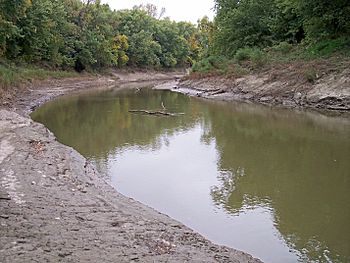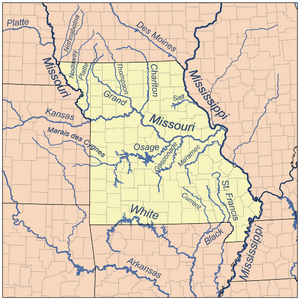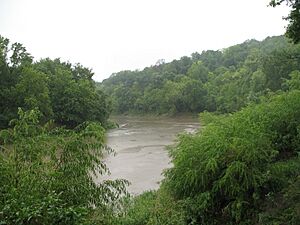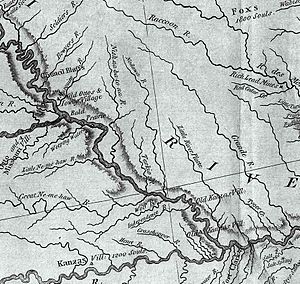Platte River (Iowa and Missouri) facts for kids
Quick facts for kids Platte River |
|
|---|---|

The Platte River near Platte City, Missouri
|
|

Map of northern Missouri rivers
|
|
| Country | United States |
| State | Iowa, Missouri |
| District | Platte County, Missouri, Buchanan County, Missouri, Andrew County, Missouri, Nodaway County, Missouri, Worth County, Missouri, Taylor County, Iowa, Ringgold County, Iowa, Adams County, Iowa, Union County, Iowa |
| Physical characteristics | |
| Main source | Creston, Iowa 1,340 ft (410 m) 41°08′57″N 94°23′00″W / 41.14917°N 94.38333°W |
| River mouth | Missouri River Platte City, Missouri 738 ft (225 m) 39°15′51″N 94°50′15″W / 39.26417°N 94.83750°W |

The Platte River is a river in the United States. It flows for about 200 miles (320 km) (320 km). This river is a tributary, meaning it flows into a larger river. The Platte River joins the mighty Missouri River. You can find it in southwestern Iowa and northwestern Missouri.
Sometimes, people call it the Little Platte River. This helps tell it apart from a much bigger Platte River in Nebraska. That other Platte River also flows into the Missouri River. Interestingly, the Platte River in Missouri even has its own smaller branch called the "Little Platte River"!
Contents
Where Does the Platte River Flow?
The Platte River begins near Creston, Iowa in Union County, Iowa. From there, it generally flows south. It travels through several counties in Iowa, including Adams, Ringgold, and Taylor.
Platte River's Journey Through Missouri
After Iowa, the river continues its journey into Missouri. It passes through Worth, Nodaway, Andrew, Buchanan, and Platte Counties.
Along its path, the Platte River flows by many towns. In Iowa, these include Maloy, Blockton, and Athelstan. In Missouri, it passes Sheridan, Parnell, Ravenwood, Conception Junction, Guilford, Tracy, Platte City, and Farley. Finally, the Platte River flows into the Missouri River near Farley. This is just downstream from Leavenworth, Kansas.
How Has the River Changed?
Over time, some parts of the river's path have been changed by people. These sections have been straightened and made into channels. This is often done to help control floods or make land more usable.
What Are the Platte River's Branches?
The Platte River has several smaller rivers and streams that flow into it. These are called tributaries.
- Near where it starts in Iowa, the Platte River collects water from three small branches. These are known as the West Platte River, Middle Platte River, and East Platte River.
- In Buchanan County, Missouri, two important streams join the Platte. One is the One Hundred and Two River. The other is the Third Fork. The Third Fork starts in Gentry County. It flows south through DeKalb County, past Union Star. The Third Fork also has its own small branch, called the Little Third Fork. This flows past Clarksdale. Before leaving Buchanan County, Castile Creek also flows into the Platte River.
- In Platte County, Missouri, the Little Platte River joins the main river. This branch starts in DeKalb County. It flows south-southwest through Clinton and Clay Counties. It passes by Plattsburg and Smithville. Near Smithville, a U.S. Army Corps of Engineers built a dam. This dam created Smithville Lake from the Little Platte River.
History of the Platte River Area
The area around the Platte River has an interesting history. It played a role in how Missouri grew.
The Platte Purchase
When Missouri became a state in 1821, its western border was set. This border followed the Missouri River from Arkansas up to the Kansas River. The land in what is now northwest Missouri was given to Native American tribes. These included the Ioway, Sac, and Fox tribes.
However, new settlers began moving into this land. One important settler was Joseph Robidoux IV in St. Joseph, Missouri. Other settlers in northern Missouri felt cut off from the Missouri River.

In 1836, William Clark (from the famous Lewis and Clark Expedition) talked with the Native American tribes. He convinced them to sell their lands in northwest Missouri. This agreement was called the Platte Purchase, named after the river. The deal was approved in 1837. The tribes were paid $7,500 for an area about the size of Delaware and Rhode Island combined. This land then became part of Missouri.
In 1838, settlers used the Platte River (and the Nodaway River) to travel into this new land. Today, the Platte River is not used for large boats. However, in the past, Missouri River steamboats used to stop at Tracy, Missouri.
The Platte River and the Civil War
During the American Civil War, the Platte River was involved in a sad event. On September 3, 1861, a group of fighters attacked a bridge over the river near St. Joseph, Missouri. They burned the bridge, causing a Hannibal & St. Joseph Railroad train to crash. This terrible event, known as the Platte Bridge Railroad Tragedy, killed between 17 and 20 people. About 200 others were hurt. It was one of the worst attacks on a passenger train during the war.
Union forces later burned parts of Platte City, Missouri in 1861 and 1864. They did this while trying to find Silas M. Gordon, who they believed led the attack.
Platte River Today
The Platte River is the largest river in the area gained by the Platte Purchase. It flows through the Kansas City metropolitan area and the St. Joseph, Missouri metropolitan area.
The river's average flow is about 1,925 cubic feet per second (54.5 cubic meters per second). The highest flow ever recorded was 37,800 cubic feet per second (1070 cubic meters per second). This happened during the Great Flood of 1993 on July 26, 1993. The lowest flow was just 12 cubic feet per second (0.33 cubic meters per second) during a dry period in August 1989.

